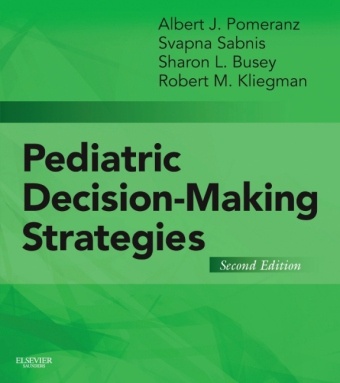Read more
Designed to accompany Nelson Textbook of Pediatricsand Nelson Essentials of Pediatrics, Pediatric Decision-Making Strategies is a concise, user-friendly reference uses a unique algorithmic approach to facilitate diagnosis, testing, basic treatment of common pediatric disorders. For any given symptom, an algorithm guides the reader through the appropriate investigative procedures and lab tests to reach definitive diagnoses. An updated format that enhances usability makes this medical reference book a must-have for medical students, residents, and practitioners treating pediatric patients.
"...it demonstrates a way of thinking about medicine that is useful in paediatrics and in all other specialties." Reviewed by Seminars in Fetal and Neonatal Medicine , Apr 2015
- Explore concise, focused, and updated algorithms that cover the most common pediatric problems.
- Gain imperative knowledge from an expert author team that includes Dr. Robert M. Kliegman (of the Nelson line of textbooks), as well as references to related chapters in both Nelson Textbook of Pediatrics and Nelson Essentials of Pediatrics.
- Quickly access important information with a new standard format and trim size for practicality and usability.
- Expert Consult eBook version included with purchase. This enhanced eBook experience allows you to search all of the text, figures, algorithms, and references from the book on a variety of devices.
List of contents
HEAD NECK and EYES_
- Ear Pain
- Rhinorrhea
- Sore Throat_
- Neck Masses_
- Abnormal Head Size, Shape, and Fontanels_
- Red Eye_
- Strabismus_
- Visual Impairment and Leukocoria_
- Abnormal Eye Movements_
RESPIRATORY SYSTEM_
- Cough_
- Hoarseness_
- Stridor_
- Wheezing_
- Cyanosis_
- Hemoptysis_
- Apnea_
CARDIOLOGY_
- Chest Pain_
- Syncope_
- Palpitations_
- Heart Murmurs_
GASTROINTESTINAL SYSTEM_
- Abdominal Pain_
- Vomiting_
- Diarrhea_
- Constipation_
- Gastrointestinal Bleeding_
- Jaundice_
- Hepatomegaly_
- Splenomegaly_
- Abdominal Masses_
GENITOURINARY SYSTEM_
- Dysuria_
- Enuresis_
- Red Urine and Hematuria
- Proteinuria_
- Edema_
- Hypertension_
- Scrotal Pain_
- Scrotal Swelling (Painless)_
- Dysmenorrhea_
- Amenorrhea_
- Abnormal Vaginal Bleeding_
- Vaginal Discharge_
MUSCULOSKELETAL SYSTEM_
- Limp_
- Arthritis_
- Knee Pain_
- Extremity Pain_
- Back Pain_
- Stiff or Painful Neck_
- In-Toeing, Out-Toeing, and Toe-Walking_
- Bowlegs and Knock-Knees_
NEUROLOGY_
- Headaches_
- Seizures and Other Paroxysmal Disorders_
- Involuntary Movements_
- Hypotonia and Weakness_
- Ataxia_
- Altered Mental Status_
- Hearing Loss_
DERMATOLOGY_
- Alopecia_
- Vesicles and Bullae_
- Fever and Rash_
HEMATOLOGY_
- Lymphadenopathy_
- Anemia_
- Bleeding_
- Petechiae/Purpura_
- Neutropenia_
- Pancytopenia_
- Eosinophilia_
ENDOCRINE SYSTEM_
- Short Stature_
- Pubertal Delay_
- Precocious Puberty in the Male_
- Precocious Puberty in the Female_
- Atypical or Ambiguous Genitalia_
- Hirsutism_
- Gynecomastia_
- Obesity_
- Polyuria_
GENERAL_
- Fever without a Source_
- Fever of Unknown Origin_
- Recurrent Infections_
- Irritable Infant (Fussy or Excessively Crying Infant)_
- Failure to Thrive_
- Sleep Disturbances_
FLUIDS AND ELECTROLYTES_
- Acidemia_
- Alkalemia_
- Hypernatremia_
- Hyponatremia_
- Hypokalemia_
- Hyperkalemia_
- Hypocalcemia_
- Hypercalcemia_
Summary
Preceded by Pediatric decision-making strategies to accompany Nelson Textbook of Pediatrics, 16th ed. / Albert J. Pomeranz ... [et al.]. c2002.
Report
"I would recommend it for students because it demonstrates a way of thinking about medicine that is useful in paediatrics and in all other specialties. I would also recommend it to junior doctors working in an assessment unit or emergency department; a quick glance at an algorithm before seeing a patient is much faster than leafing through pages of text." Reviewed by Seminars in Fetal and Neonatal Medicine , Apr 2015

